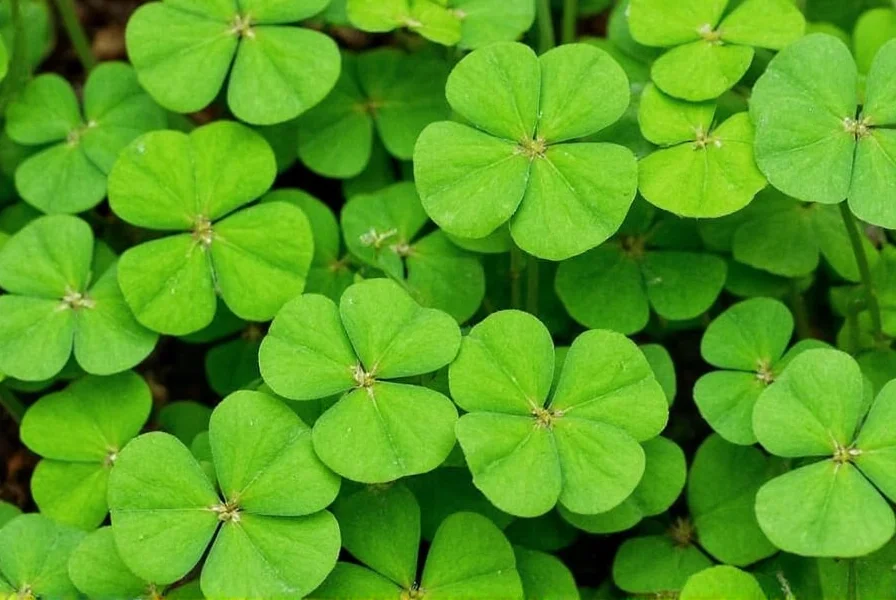Clover gardens offer an eco-friendly alternative to traditional grass lawns, providing nitrogen fixation, drought tolerance, and low-maintenance ground cover. White clover (Trifolium repens) is the most popular variety for residential gardens due to its ability to thrive in various soil conditions while requiring minimal watering, mowing, and fertilization compared to conventional turfgrass.
For gardeners seeking sustainable landscaping solutions, clover presents a practical option that supports biodiversity while reducing water consumption and eliminating the need for synthetic fertilizers. This resilient ground cover forms a dense mat that naturally suppresses weeds and withstands foot traffic better than many expect. Unlike traditional lawns that demand regular irrigation and chemical treatments, clover gardens thrive with minimal intervention once established, making them particularly valuable in regions experiencing water restrictions or for environmentally conscious homeowners.
Why Choose Clover for Your Garden?
Clover's unique biological properties make it an exceptional garden companion. As a legume, it hosts nitrogen-fixing bacteria in root nodules, converting atmospheric nitrogen into a form plants can use. This natural fertilization process enriches soil fertility without synthetic inputs, benefiting nearby plants while reducing your gardening workload. The dense growth habit of clover varieties like microclover creates an attractive, weed-resistant ground cover that maintains its green color throughout dry periods when traditional grass would brown.

Popular Clover Varieties for Gardens
Not all clovers serve the same purpose in garden settings. Understanding the differences helps you select the right variety for your specific needs:
- White Clover (Trifolium repens) - The classic choice for lawns, growing 4-8 inches tall with creeping stems that root at nodes. Dutch white clover features smaller leaves and flowers than the standard variety.
- Microclover (Trifolium repens var. Pipolina) - A refined option with 30% smaller leaves and reduced flowering, creating a more uniform appearance that blends better with traditional lawns.
- Strawberry Clover (Trifolium fragiferum) - Tolerates wetter conditions and saline soils better than white clover, with distinctive pink flower heads.
- Crimson Clover (Trifolium incarnatum) - Primarily used as a cover crop but can work in ornamental gardens with its striking red flowers, though it's less durable as a permanent ground cover.
Establishing Your Clover Garden
Creating a successful clover garden requires proper preparation and timing. The optimal planting window is early spring or early fall when temperatures range between 50-75°F (10-24°C). Begin by clearing existing vegetation either through solarization, smothering, or careful herbicide use if necessary. Clover seeds need direct soil contact to germinate effectively, so rake the area to create a loose seedbed.
For new installations, broadcast 2-3 pounds of seed per 1,000 square feet, mixing with sand for even distribution. When overseeding existing lawns, use 1-2 pounds per 1,000 square feet after mowing short and removing clippings. Lightly rake the seeds into the top quarter-inch of soil or use a roller for better seed-to-soil contact. Keep the area consistently moist until seedlings establish, typically 7-14 days.
| Feature | Clover Lawn | Traditional Grass Lawn |
|---|---|---|
| Water Requirements | 1/3 less than grass; drought-tolerant once established | Requires regular watering (1-1.5 inches/week) |
| Fertilization Needs | None (fixes its own nitrogen) | Regular applications needed |
| Mowing Frequency | Optional; mow 1-2 times monthly for formal look | Weekly during growing season |
| Pest Resistance | Naturally resistant to most lawn pests | Vulnerable to grubs, chinch bugs |
| Soil Health Impact | Improves soil fertility through nitrogen fixation | Depletes soil nutrients over time |
Maintenance Requirements
One of clover's greatest advantages is its minimal maintenance needs. Unlike traditional lawns requiring weekly mowing, clover only needs occasional trimming if you prefer a manicured appearance. Many gardeners allow it to grow naturally, reaching 6-8 inches before flowering. If you choose to mow, set your mower to at least 3 inches to avoid damaging the plants.
Weed control becomes significantly easier with established clover. The dense growth pattern naturally suppresses most weeds, though persistent invaders may require spot treatment. Avoid broad-spectrum herbicides as they will damage your clover. For problem weeds, hand-pulling or targeted organic solutions work best. Clover typically requires reseeding every 2-3 years to maintain density, though this depends on traffic levels and climate conditions.
Addressing Common Concerns
Many gardeners hesitate to adopt clover gardens due to misconceptions about appearance and practicality. While traditional white clover produces small white flowers that attract bees, newer microclover varieties bloom less frequently and with smaller flowers. If bee activity concerns you, mowing during peak bloom period reduces flower visibility. Clover's texture differs from grass, feeling slightly softer underfoot, which many find pleasant but requires adjustment for those accustomed to traditional turf.
Another consideration is clover's performance in high-traffic areas. While it withstands moderate foot traffic well, heavily used pathways may require reinforcement with stepping stones or a clover-grass blend. In extremely hot climates (above 90°F/32°C), clover may go dormant during summer months but typically recovers with cooler temperatures or rainfall.
Environmental Benefits of Clover Gardens
Beyond personal convenience, clover gardens contribute significantly to ecological health. The flowers provide essential nectar sources for pollinators, supporting declining bee populations. By eliminating the need for synthetic fertilizers, clover reduces chemical runoff into waterways. The deep root system improves soil structure and water infiltration, reducing erosion and stormwater runoff. Homeowners who switch from traditional lawns to clover can reduce their water consumption by up to 50%, a critical consideration in drought-prone regions.
Seasonal Care Calendar
Understanding clover's seasonal patterns helps maintain a healthy garden throughout the year:
- Spring: Clover emerges early, often greening up weeks before grass. This is the ideal time for overseeding bare spots.
- Summer: While traditional lawns struggle, clover maintains color with minimal water. Mow occasionally to control flowering if desired.
- Fall: Cooler temperatures stimulate vigorous growth. This is the best time for establishing new clover gardens.
- Winter: In mild climates, clover remains green year-round. In colder zones, it goes dormant but greens up quickly in spring.
Practical Implementation Tips
For best results when converting to a clover garden, consider these practical recommendations:
- Start small with a test area before committing your entire yard
- Mix clover with fine fescue grass for improved traffic tolerance
- Avoid planting in areas with constant heavy foot traffic
- Use a dedicated clover seed mix rather than generic "lawn" mixes
- Water deeply but infrequently to encourage deep root development
Frequently Asked Questions
Does clover attract more bees than traditional lawns?
Yes, clover flowers do attract bees, which benefits pollinator populations. White clover produces small white flowers that bees find attractive, particularly during dry periods when other nectar sources are scarce. If bee activity concerns you, consider microclover varieties that flower less frequently, or mow during peak bloom periods to reduce flower visibility. The presence of bees indicates a healthy ecosystem, and most clover varieties pose minimal stinging risk as bees are typically focused on nectar collection.
How does clover perform in shady areas compared to grass?
Clover generally performs better in partial shade than many traditional turfgrasses. While it prefers full sun (6+ hours daily), white clover can tolerate moderate shade conditions where grass might struggle. In heavily shaded areas (less than 3 hours of direct sun), clover growth will be thinner and less vigorous. For optimal results in shady gardens, consider mixing clover with shade-tolerant grass varieties like fine fescue, or choose alternative ground covers better suited for deep shade conditions.
Can I use clover in high-traffic areas like play spaces?
While clover withstands moderate foot traffic well, it's not ideal for high-traffic areas like children's play spaces where constant running and jumping occurs. In these zones, clover may thin out or develop bare spots. For play areas, consider using a clover-grass blend with durable grass varieties like perennial ryegrass, or install stepping stones in high-traffic pathways within your clover garden. Microclover varieties generally handle foot traffic better than standard white clover due to their more compact growth habit.
Does clover require special care during winter months?
Clover care during winter depends on your climate zone. In mild climates (zones 7+), clover often remains green year-round with minimal care. In colder regions (zones 6 and below), clover typically goes dormant during freezing temperatures but doesn't require special winter preparation. Avoid walking on frozen clover plants, as this can cause damage. In early spring, clover greens up weeks before traditional grass, requiring no special revival treatments. In areas with heavy snow cover, clover usually emerges healthy once temperatures warm.
How often should I reseed my clover garden?
Most clover gardens benefit from overseeding every 2-3 years to maintain density, though this varies based on climate, soil conditions, and traffic levels. Signs that reseeding is needed include thinning patches, increased weed invasion, or reduced flowering. The best times for overseeding are early spring or early fall when soil moisture and temperatures support germination. Use approximately 1 pound of seed per 500 square feet for established areas, lightly raking it into the soil surface for best results. Avoid reseeding during hot, dry summer months when germination rates are poor.











 浙公网安备
33010002000092号
浙公网安备
33010002000092号 浙B2-20120091-4
浙B2-20120091-4